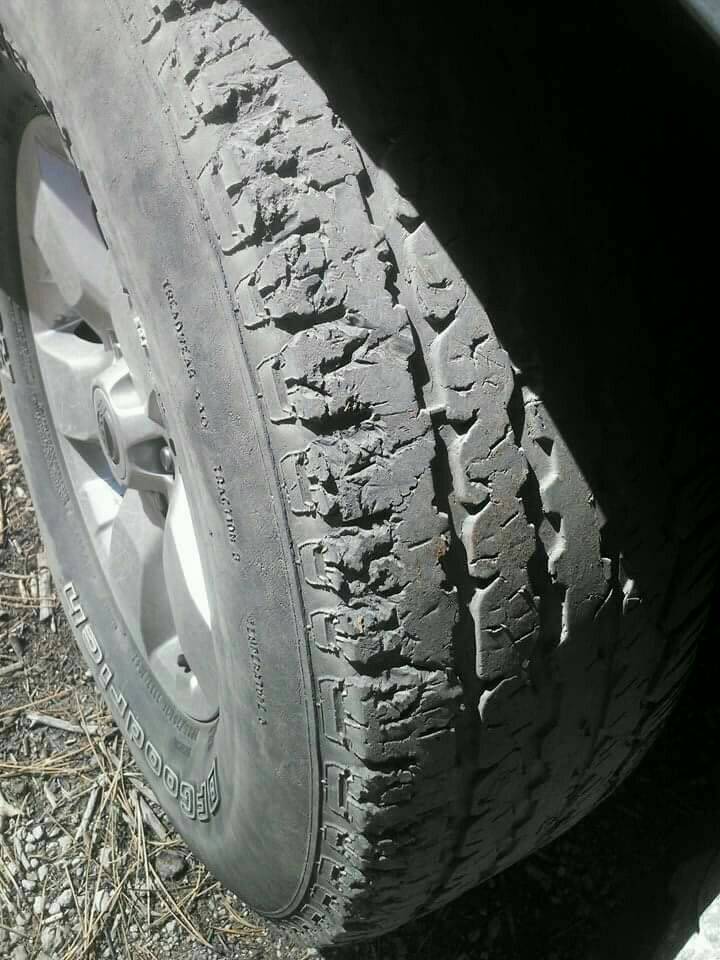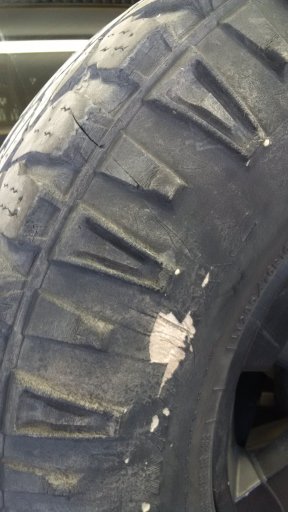Hey all, i knownone day I will want to.do this. I juat dont have any data to go off of. Such as how low psi can i go and still have pavement worthy tires? Also i know most off roaders have 16's or 17's. I have 18's and not sire how that will effect what can or cannot be done. Any imput from.the experianced?
Airing down tires.
- Thread starter Meta6981
- Start date
-
Guest, UPDATE We went through the site migration runbook and completed all steps. We will need to complete the migration next week, but will leave the forums up for the weekend. A few days after maintenance, a major upgrade revision to the forum site will occur.
I go down to about 20 psi with my 18s sometimes lower if i need to. I works fine, just realize you have a shorter sidewall so some times my rims find rocks they wouldnt if i had 16s or 17s.
Cool thanks, also why i got steel rims for that set.I go down to about 20 psi with my 18s sometimes lower if i need to. I works fine, just realize you have a shorter sidewall so some times my rims find rocks they wouldnt if i had 16s or 17s.
Also dont drive that far aired down on pavement not good for tires a few miles should be fine, but aired down tires build a lot of heat and it can cause your tire to fail

Pathfinder II
Here's my response from another related thread here:
Deflating for comfortable ride
I had the opportunity to speak with an individual (who shall remain nameless) within the BFG corporation. This particular gentleman was an engineer who helped develop a lot of the tires we run today. He told me (officially) that he can not condone running their tires at a lower PSI than recommended. However, (unofficially) he confirmed that running at a lower PSIunder the right circumstances would not degrade the integrity of the tire itself.
That being said; there are several factors to consider when selecting a proper PSI... this was some of his input on the subject:
1) Wheel size versus overall tire size.
So how much meat (rubber) do you have between the rim and the rock you're about to hit? If you're running 15" wheels with 35 or 37 inch tires you can go down in the 10 PSI range with no issues. If you're trying to run 18" wheels then 20 PSI is probably as low as you want to go if there's a chance you'll tag a rock. The reason for this is you can actually damage the interior of your tire if you were to pinch the tire between a rock and the rim. This type of damage will go unnoticed until you either remove the tire, or have a blowout...
2) Speed.
The rate at which the tire deforms and reforms can have an adverse affect on the sidewall as well. If you're running 55 MPH down a paved road to a trail head at 18 PSI you're generating a ton of heat due to the constant deforming and reforming of the tire footprint. It doesn't take long to do irreparable damage to a tire under these conditions (which is also hidden to the user). Consider airing up even if it's just a short run down a hard surface at speed.
3) Surface.
This factor goes hand-in-hand with speed. The type of surface you're running on can make all the difference on PSI selection. For example, if you're running on sand, the surface itself is helping support the integrity of the tire since it is also deforming to accept the footprint of the tire. You can typically run much lower PSI on sand due to this fact. Rocky trails at slow speeds are also good candidates for lower PSI since you want more deformation to avoid a puncture or cut. Gravel roads would be a bit less forgiving especially if they are hard packed. Consider a medium range PSI.
4) Aggressiveness of steer.
Basically this means; how hard will you been cutting the wheel at speed? You can run 2-5 PSI in sand... in a straight line. If you plan on doing donuts then you're probably going to blow a bead... and possibly roll your rig if you're carrying enough speed. Same for rock crawling, if you're at an extremely low PSI and try to cut hard while in a bind, you're likely to blow the bead.
The final decision on PSI is really up to you. It's your rig, so experiment with different settings until you find those sweet spots for your unit's wheels-to-tire size ratio and final weight. I highly recommend investing in some quality deflators (Stuan or ARB) and a 100% duty rated air compressor (Dual compressor ARB unit is incredible) to save a lot of headache and time. Also, get a quality air pressure gauge... that free one from NAPA ain't no good! (After tons of research I got a digital craftsman unit from amazon)
And if you do blow a bead... try a heavy duty ratchet strap (kept in the tool kit) for wrapping around the tire while re-seating.
Here are my typical PSI settings for our 2014 4Runner running BFG KO's in 275/70R17 Load Range E:
Every day travel: 40 PSI front 42 PSI rear (45 PSI in rear if loaded)
Highway between trails: 30-32 PSI (Used this in Colorado since our route had highways in between trail heads)
Gravel Roads: 20 PSI (24 PSI in rear if loaded)
Rocky Trails: 16 PSI (18 in rear if loaded)
Sand: 14 PSI (18 PSI in rear if loaded)
Deflating for comfortable ride
I had the opportunity to speak with an individual (who shall remain nameless) within the BFG corporation. This particular gentleman was an engineer who helped develop a lot of the tires we run today. He told me (officially) that he can not condone running their tires at a lower PSI than recommended. However, (unofficially) he confirmed that running at a lower PSIunder the right circumstances would not degrade the integrity of the tire itself.
That being said; there are several factors to consider when selecting a proper PSI... this was some of his input on the subject:
1) Wheel size versus overall tire size.
So how much meat (rubber) do you have between the rim and the rock you're about to hit? If you're running 15" wheels with 35 or 37 inch tires you can go down in the 10 PSI range with no issues. If you're trying to run 18" wheels then 20 PSI is probably as low as you want to go if there's a chance you'll tag a rock. The reason for this is you can actually damage the interior of your tire if you were to pinch the tire between a rock and the rim. This type of damage will go unnoticed until you either remove the tire, or have a blowout...
2) Speed.
The rate at which the tire deforms and reforms can have an adverse affect on the sidewall as well. If you're running 55 MPH down a paved road to a trail head at 18 PSI you're generating a ton of heat due to the constant deforming and reforming of the tire footprint. It doesn't take long to do irreparable damage to a tire under these conditions (which is also hidden to the user). Consider airing up even if it's just a short run down a hard surface at speed.
3) Surface.
This factor goes hand-in-hand with speed. The type of surface you're running on can make all the difference on PSI selection. For example, if you're running on sand, the surface itself is helping support the integrity of the tire since it is also deforming to accept the footprint of the tire. You can typically run much lower PSI on sand due to this fact. Rocky trails at slow speeds are also good candidates for lower PSI since you want more deformation to avoid a puncture or cut. Gravel roads would be a bit less forgiving especially if they are hard packed. Consider a medium range PSI.
4) Aggressiveness of steer.
Basically this means; how hard will you been cutting the wheel at speed? You can run 2-5 PSI in sand... in a straight line. If you plan on doing donuts then you're probably going to blow a bead... and possibly roll your rig if you're carrying enough speed. Same for rock crawling, if you're at an extremely low PSI and try to cut hard while in a bind, you're likely to blow the bead.
The final decision on PSI is really up to you. It's your rig, so experiment with different settings until you find those sweet spots for your unit's wheels-to-tire size ratio and final weight. I highly recommend investing in some quality deflators (Stuan or ARB) and a 100% duty rated air compressor (Dual compressor ARB unit is incredible) to save a lot of headache and time. Also, get a quality air pressure gauge... that free one from NAPA ain't no good! (After tons of research I got a digital craftsman unit from amazon)
And if you do blow a bead... try a heavy duty ratchet strap (kept in the tool kit) for wrapping around the tire while re-seating.
Here are my typical PSI settings for our 2014 4Runner running BFG KO's in 275/70R17 Load Range E:
Every day travel: 40 PSI front 42 PSI rear (45 PSI in rear if loaded)
Highway between trails: 30-32 PSI (Used this in Colorado since our route had highways in between trail heads)
Gravel Roads: 20 PSI (24 PSI in rear if loaded)
Rocky Trails: 16 PSI (18 in rear if loaded)
Sand: 14 PSI (18 PSI in rear if loaded)
Great write up! Thanks for sharing! Lots of good information, exactly whay i was looking for.
E
expeditionnorth
Guest
from several tire training seminars we were told airing down only sells tires so they let the myths exist
when you air down you are basically closing the tire gap between the tread which defeats the whole purpose of the tread in the first place
I'll shut up before I start a debate
when you air down you are basically closing the tire gap between the tread which defeats the whole purpose of the tread in the first place
I'll shut up before I start a debate

Influencer II
LOL... ok.
When you are offroad and go up against a sharp rock with a fully inflated tire you'll change your tune... never mind the obvious comfort factor for you and everything in your vehicle.
When you are offroad and go up against a sharp rock with a fully inflated tire you'll change your tune... never mind the obvious comfort factor for you and everything in your vehicle.
You are also widening the contact patch. More contact = more traction.from several tire training seminars we were told airing down only sells tires so they let the myths exist
when you air down you are basically closing the tire gap between the tread which defeats the whole purpose of the tread in the first place
I'll shut up before I start a debate
Also, a tire that conforms a bit more to obstacles is less likely to puncture than a fully aired up tire.
Someone done steered you wrong.
Here's one of my tires after my first trip to the high Sierras 10 years ago. Keep in mind, I grew up wheeling forest trails, so airing down wasn't a big "thing"
Now, I run like 16-18 psi religiously, lol

Now, I run like 16-18 psi religiously, lol


Pathfinder II
It sounds like you may have received some bad information. You should try airing down next time you're out... I love watching the looks on people's faces when they do it for the first time. It's soooo much better on your backside, and your equipment overall; not to mention the traction benefits.from several tire training seminars we were told airing down only sells tires so they let the myths exist
when you air down you are basically closing the tire gap between the tread which defeats the whole purpose of the tread in the first place
I'll shut up before I start a debate

Influencer II
No kidding eh? I've seen some pretty wide eyes and big smiles when I showed them the benefits of airing down.It sounds like you may have received some bad information. You should try airing down next time you're out... I love watching the looks on people's faces when they do it for the first time. It's soooo much better on your backside, and your equipment overall; not to mention the traction benefits.
Oh and here's my tire... pretty damn sure that if it was aired up when I was wheeling in those sharp rocks I would have had a sliced sidewall.
Notice all the cuts near the white portion and the deep cut all the way into my tread.

(almost time for new tires... this is now my spare)
Ive seen several flats from people not airing down and the traction when crawling without airing down is terrible. Also the ride is so much smoother with aired down tires. Totally worth it. I usually go down to 20 for overlanding/fireroad stuff. I go to 15 for offroadng.
I usually run 18-20 psi and i have 17 " rims and 31" tires at the moment.. I always wait to air down at the trailhead and air up as soon as i hit the end or pavement. Paranoid alittle on running them on pavement at low psi.
I am going to do a testing run in August at hollister hills. They have an air station at the ranger station. I should be able to experiment a bit. I think I a, going to run at 25 psi first and then go from there. Orem specs for my rig are 36 up front and 40 in rears.
Thats cool play around with it every truck is different. My cousin aired down to 15 psi on his pick up i aired down to 20 to get the same effect. The more you play with it the more you will know what psi works for your rig.I am going to do a testing run in August at hollister hills. They have an air station at the ranger station. I should be able to experiment a bit. I think I a, going to run at 25 psi first and then go from there. Orem specs for my rig are 36 up front and 40 in rears.
From my first time ever wheeling I have aired down. The big eye opener was one day when we found a place to play for a bit by surprise. We were only planning on being there for a very short time so I didn't air down. I kept trying this climb and just couldn't make so I aired down to 20psi and just walked right up it. Whenever the plan is to wheel unlike that situation, I always air down and usually to 10psi if not a little lower. I am running 35" tires on 16" rims but they are dual bead locks so I can safely go that low. Before the bead locks I would go to 15-20 psi depending on the situation.
Here's my response from another related thread here:
Deflating for comfortable ride
I had the opportunity to speak with an individual (who shall remain nameless) within the BFG corporation. This particular gentleman was an engineer who helped develop a lot of the tires we run today. He told me (officially) that he can not condone running their tires at a lower PSI than recommended. However, (unofficially) he confirmed that running at a lower PSIunder the right circumstances would not degrade the integrity of the tire itself.
That being said; there are several factors to consider when selecting a proper PSI... this was some of his input on the subject:
1) Wheel size versus overall tire size.
So how much meat (rubber) do you have between the rim and the rock you're about to hit? If you're running 15" wheels with 35 or 37 inch tires you can go down in the 10 PSI range with no issues. If you're trying to run 18" wheels then 20 PSI is probably as low as you want to go if there's a chance you'll tag a rock. The reason for this is you can actually damage the interior of your tire if you were to pinch the tire between a rock and the rim. This type of damage will go unnoticed until you either remove the tire, or have a blowout...
2) Speed.
The rate at which the tire deforms and reforms can have an adverse affect on the sidewall as well. If you're running 55 MPH down a paved road to a trail head at 18 PSI you're generating a ton of heat due to the constant deforming and reforming of the tire footprint. It doesn't take long to do irreparable damage to a tire under these conditions (which is also hidden to the user). Consider airing up even if it's just a short run down a hard surface at speed.
3) Surface.
This factor goes hand-in-hand with speed. The type of surface you're running on can make all the difference on PSI selection. For example, if you're running on sand, the surface itself is helping support the integrity of the tire since it is also deforming to accept the footprint of the tire. You can typically run much lower PSI on sand due to this fact. Rocky trails at slow speeds are also good candidates for lower PSI since you want more deformation to avoid a puncture or cut. Gravel roads would be a bit less forgiving especially if they are hard packed. Consider a medium range PSI.
4) Aggressiveness of steer.
Basically this means; how hard will you been cutting the wheel at speed? You can run 2-5 PSI in sand... in a straight line. If you plan on doing donuts then you're probably going to blow a bead... and possibly roll your rig if you're carrying enough speed. Same for rock crawling, if you're at an extremely low PSI and try to cut hard while in a bind, you're likely to blow the bead.
The final decision on PSI is really up to you. It's your rig, so experiment with different settings until you find those sweet spots for your unit's wheels-to-tire size ratio and final weight. I highly recommend investing in some quality deflators (Stuan or ARB) and a 100% duty rated air compressor (Dual compressor ARB unit is incredible) to save a lot of headache and time. Also, get a quality air pressure gauge... that free one from NAPA ain't no good! (After tons of research I got a digital craftsman unit from amazon)
And if you do blow a bead... try a heavy duty ratchet strap (kept in the tool kit) for wrapping around the tire while re-seating.
Here are my typical PSI settings for our 2014 4Runner running BFG KO's in 275/70R17 Load Range E:
Every day travel: 40 PSI front 42 PSI rear (45 PSI in rear if loaded)
Highway between trails: 30-32 PSI (Used this in Colorado since our route had highways in between trail heads)
Gravel Roads: 20 PSI (24 PSI in rear if loaded)
Rocky Trails: 16 PSI (18 in rear if loaded)
Sand: 14 PSI (18 PSI in rear if loaded)
Perfect response IMO, great work!





